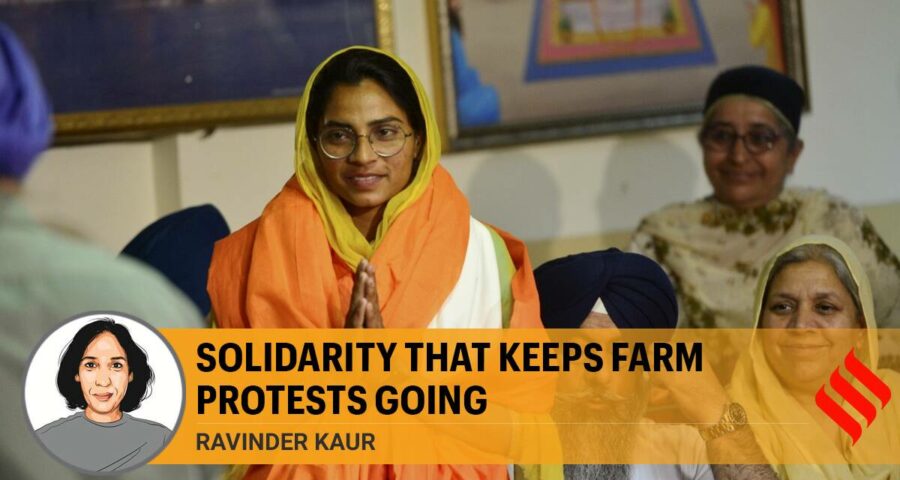The solidarity between different caste and occupational groups is still fragile but for now the protest has opened new space for workers and farmers to forge solidarity in their struggle.
The farmers’ protests crossed the crucial 100 days threshold last week. In the summer of 2020, agrarian discontent had started building up in the Punjab countryside, and by late November, the first protest sites began appearing along the borders of Delhi. Singhu, Tikri, Shahjahanpur Kheda, Ghazipur, once just names of villages at the doorstep of the city, have since become a part of the popular vocabulary of democratic protest. Perhaps, the most remarkable aspect of the protest is that it still endures half a year on. Few political observers had given even half a chance to the farmers’ unions when they began their journey from Punjab to Delhi. Yet, the winter of discontent is now shifting into summer.
While the outcome of the movement is still unclear, two key re-configurations unfolding in the social-political landscape are already apparent. First, the social constitution of the movement has continued to evolve in the past months. Central to this shift is the bid to forge solidarity across caste formations and the attendant class interests. A visible sign of this ongoing reconfiguration on the ground was the celebration of Guru Ravidas Jayanti by the farmers’ unions two weeks ago. The significance of this celebration lays in how it seeks to bridge caste differences between Jat and Dalit communities in the agrarian economy. Second, is the related effort to conjoin the struggle of the farmers with the struggle of the workers. A week ago, Samyukta Kisan Morcha joined hands with the trade unions to campaign against the farm laws as well as the labour codes. This is the first time that producers — farmers and workers — have sought to form an alliance in the past three decades of economic reforms. It is yet uncertain what these efforts might lead to but it is clearly a pushback against unfettered capitalism, a condition that has rendered a vast population vulnerable to market vagaries.
What has unsettled the status quo is the emergence of a new youth leadership alongside established farmers and workers unions. Key figures in this shifting landscape are Dalit labour rights activists like Nodeep Kaur and Shiv Kumar who early on articulated the logic of why industrial workers are joining farmers’ protests. Nodeep Kaur, in an interview explained as follows: “farmers and workers are tied together. They are both producers. Farmers produce on the fields and workers produce in factories. Both these groups are sliding backwards… The Bills passed against the workers and those passed against the farmers should be revoked.” These arguments were deemed peripheral three months ago but have increasingly gained credence. The slogan of ‘Kisan-Mazdoor Ekta Zindabaad’ — Long live farmer-worker unity! — which originally envisaged solidarity between farmers and farm labourers has shown the expansive capacity to include industrial workers.
The cultural resource this unsettled social landscape draws upon is an old blueprint: of anti-caste egalitarianism that has long shaped Sikh cultural practices. The ideas from which the movement draws its moral-intellectual energy are deeply familiar, ideas that in this moment of crisis have gained new relevance. The utopian notion of Begamapura (the city without sorrow) envisioned by Guru Ravidas is frequently invoked at the protest — the radical, imaginary city without discrimination, a city without property, a city of harmony that welcomes everyone. The egalitarian impulse draws upon Guru Nanak’s vision of a non-hierarchical society, an idea that sought to subvert the caste order half a millennia ago. These anti-caste ideas were translated into the practice of langar – that invites everyone to eat together; seva (service) and keerat (work/deed) that dignify labour, all of which weaken caste/class hierarchies. Those who witness the protest often remark how men and women together articipate in cooking and cleaning, and how manual labour is performed by many across social hierarchies. What is on display are centuries-old ideas which are resonating once again among a people engaged in a contemporary struggle against market deregulations.
Yet, the question of solidarity is not an uncomplicated one. We might ask: what does solidarity even mean in a political landscape in which caste stratifications, religious frictions, and varied class interests have not yet disappeared? Any bid to forge a common identity, then, inevitably means not airbrushing out social divisions along the intersections of class, caste, and gender that shape the agrarian economy. The landless Dalit workers form the backbone of the agricultural sector but own barely three per cent of land in Punjab. Given that a vast majority of farm landholdings are small or marginal, and farmers are often burdened with heavy debt, the looming risk of landlessness always abounds. The new farm laws combined with the new labour laws threaten to worsen the long-simmering economic crisis.
The solidarity between different caste and occupational groups is still fragile but for now the protest has opened new space for workers and farmers to forge solidarity in their struggle.
This article first appeared in the print edition on March 7, 2021 under the title ‘Solidarity that keeps farm protests going’. Ravinder Kaur is a historian of contemporary India based in Copenhagen. Suraj Yengde, author of Caste Matters, curates the fortnightly ‘Dalitality’ column.
Source: Read Full Article


